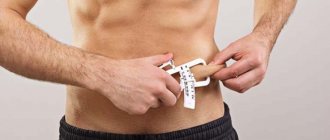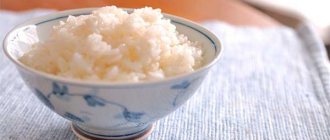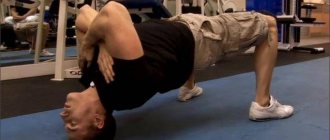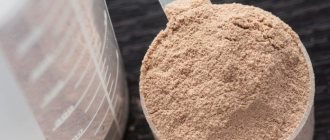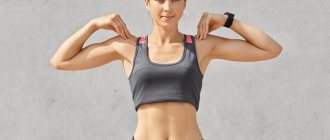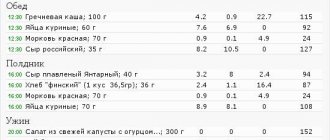Sugar is not cubes of refined sugar or a loose white substance. The term sugar refers to glucose, which is a monosaccharide.
Why is sugar important for building muscle? The answer is simple: in order for protein, which is the main building material for muscles, to be absorbed, the presence of sugar in the body is necessary. Otherwise, the body begins to produce this sugar on its own and, as you probably already guessed, from protein. In other words, sugar has significant anabolic potential.
So, how does the sugar-muscle mechanism actually work?
Glucose stimulates the body's production of such a powerful anabolic substance as insulin. It is a mistaken belief that only the hormone testosterone is important for the development of muscle mass. The fact is that testosterone only gives impetus to the start of muscle growth, but this whole process occurs only due to the presence of insulin. I hope you can guess that if there is a lack of insulin in the body, then there will be no question of any muscle growth.
The fundamental difference between insulin and testosterone is that the level of insulin in the body is very easy to influence. As soon as glucose enters the body, the insulin level immediately begins to rise, because. the pancreas begins to produce it at an increased rate. Does it really look like some kind of doping?
Well, you shouldn’t “play around” with insulin production. This matter must be approached with full responsibility and understanding.
Artificial stimulation of insulin secretion has only recently begun. But now this method is actively used to trigger post-workout anabolism.
Action plan
— After a workout, the body is especially predisposed to absorb sugar. However, it should be consumed as a liquid food. The ideal option for an athlete would be a carbohydrate-protein shake. The ratio of cocktail ingredients should be 3:1, and this proportion must be strictly observed. Exceeding doses “for the sake of benefit” may not only not help, but also cause harm. Instead of replenishing glycogen stores in the body for further muscle growth, when there is excess protein, the body will begin to produce glucagon, a hormone that speeds up the process of glycogen processing.
— To replenish sugar in the body, it is better to use monosaccharides - glucose and dextrose. The size of their cells is microscopic, and therefore they easily penetrate into the blood through the walls of the stomach. Of course, it is worth mentioning fructose, which is also a monosaccharide. But only to warn you against mistakes. Fructose, unfortunately, is not absorbed by the intestines, and therefore does not affect the production of insulin by the pancreas. At the same time, fructose has a beneficial effect on the production of glycogen by the liver. Thus, fructose can also be used, but it is better to mix it with dextrose and glucose.
— After each workout, you need to make up for the lack of carbohydrates in the body. If you do not consume carbohydrates on time, glycogen deficiency may occur. Lack of glycogen leads to a decrease in the energy potential of the workout; the athlete cannot train for a long time at high intensity, which is especially important for strength training. In addition, carbohydrate actively interacts with water, retaining it in the muscles. Thanks to this, the muscles retain their shape, elasticity and do not “dry out”.
— The amount of sugar consumed should be about 1-1.5 grams of carbohydrates with a high glycemic index per kilogram of the athlete’s weight.
- With “impact” training, sugar consumption after training should increase even more. Negative loads slow down the restoration of glycogen reserves. To quickly and fully recover after such training, you need to consume sugar at the rate of 3 g of carbohydrates per kilogram of the athlete’s weight.
— To make it easier to trigger the mechanism of post-workout anabolism, you should drink an aqueous solution of glucose and fructose before starting a workout. This is done to prevent the body's sugar and insulin stores from becoming too depleted. In addition, insulin prevents the negative effects of cortisol on the body. (Remember that cortisol breaks down muscle tissue in the body.)
Possibilities of insulin
Insulin reacts with glucose, removing it from the body and converting it into glycogen. If there is enough glycogen in the body, it turns into subcutaneous fat. Hence all the rumors that sweets lead to obesity. But what is true for the average person is completely wrong for an athlete. Exhaustive workouts deplete the body's glycogen stores. Accordingly, it requires replenishment. In the process of replenishing the lack of sugar in the muscles, other beneficial substances and amino acids are transferred into them along with sugar, which are intensively absorbed by tired muscles. In addition, due to the increased absorption of water by muscle cells, their visual enlargement occurs, which is very good for bodybuilders.
Mistake #1. Excess sugar
| ! | Abuse of sugar leads to diabetes and increased cholesterol levels. |
Sugar is a close relative of carbohydrates. Sugar reduces anabolic potential and is harmful to health. It also helps reduce insulin sensitivity. Abuse of sugar leads to diabetes and increased cholesterol levels.
Conclusion . You should follow a diet consisting of natural products with a minimum of sugars. It is necessary to reduce the consumption of confectionery products and soda. Be sure to pay attention to the ingredients of the products!
Mistake #2. Beer after the gym
| ! | Drinking beer after the gym will only do harm. |
Beer contains complex carbohydrates. But it is quite difficult for the body to break them down. It’s easier for him to put them into storage (to build up fat) than to break them down. In addition, beer contains alcohol, which even in small doses will negatively affect muscle building.
What are the consequences of drinking beer after the gym?
- One bottle of beer corresponds to missing 1 workout.
- Constant consumption of beer leads not only to stagnation, but also to a decrease in muscle growth.
- Testosterone levels decrease.
- Fat reserves increase.
Conclusion: beer after the gym will only do harm.
https://youtu.be/L9xGiN4Xzz8
Mistake #3. Abuse of fast carbohydrates
Eating everything and more is a sure way to increase fat mass. Fast carbohydrates provide a lot of energy in the shortest possible time. They are quickly absorbed, causing a sharp increase in blood sugar levels. In response to this, the human body converts glucose into fat.
But there are no such problems with complex carbohydrates. Complex carbohydrates stabilize blood glucose and also help maintain normal insulin secretion.
If you have a lack of energy, you can use a gainer. There are 2 types of gainers: with fast and with complex carbohydrates. A gainer with fast carbohydrates is necessary for extremely intense training in conditions of acute lack of energy. If everything is fine with this, then it is better to take a gainer with complex carbohydrates. Energy when taking such products will flow slowly and over a long period of time.
Conclusion .
You should follow a diet consisting of natural products, controlling the amount of fast carbohydrates.
How to reduce your sugar intake. What to replace it with.
But what if you are unable to limit your sugar intake to the daily recommended amount? Ask yourself a question: are you really ready to voluntarily surrender to “sugar slavery” and, risking your own health, give preference to momentary pleasure? If not, I suggest you take control of yourself and start changing the way you think about what you eat right now.
- To reduce your sugar intake, try a 10-day detox diet. During these days, you will have to give up all foods containing sugar, as well as dairy products and gluten. This will help you cleanse your body and get rid of addiction.
- Your sugar intake will be more likely to reach an acceptable level if you get enough sleep. Research shows that lack of just two hours of sleep provokes cravings for fast carbohydrates. If you get enough sleep, it will be much easier for you to overcome sweet cravings. When we don’t get enough sleep, we try to replenish the lack of energy and automatically reach for food. As a result, we overeat and gain weight, which is not good for anyone.
- There is no doubt that our lives today are oversaturated with stress. This risks causing cortisol levels in our body to rise, causing poorly controlled hunger pangs. Fortunately, there is a solution, and it is quite simple. Scientists advise practicing deep breathing techniques. Spend just a few minutes breathing deeply and a special nerve, the vagus nerve, will change the course of your metabolic processes. Instead of forming fat deposits on your stomach, they will begin to be burned, and this is exactly what you need.
Sugar, the benefits and harms of which should be fully understood by modern people, should not become a drug. Everything is good in moderation, and the use of such a not entirely safe product is even more so.
Video on the topic
Watch a video about how much sugar you can consume per day: https://www.youtube.com/watch?v=F-qWz1TZdIc
ul
Mistake #4. You eat too much prepared meat
| ! | Cooked meat contains too many harmful substances. |
Prepared meat, which is sold in stores and cafes, contains a large number of preservatives, additives and second-rate proteins. These components, when used frequently, lead to a decrease in muscle protein synthesis. In addition, manufacturers, in pursuit of profit, replace product components with cheaper analogues. For example, soy has long been used in sausage, ham, and sausages. The amount of protein in such products often tends to zero.
The best sources of protein: fish, chicken, pork, beef, lamb. Also, we must not forget about milk, cottage cheese, eggs.
Why sugar affects excess weight
Insulin places glucose and other monosaccharides in hepatocytes - liver cells, myocytes - muscle cells and adipocytes - adipose tissue cells. In liver and muscle cells, glycolysis occurs, the formation of glycogen. A certain amount of substrate needed for the functioning of liver cells and to provide energy to myocytes can “fit” here.
And the less you move, the less energy your muscles consume. Consequently, all excess glucose that is in the blood goes into adipose tissue. Adipocytes are getting bigger, and you are getting fatter.
What products will help maintain youthful skin?
Mistake #6. Saturated fats
Saturated fats are highly nutritious and high in calories. The body primarily uses carbohydrates to grow muscle and produce energy, so most saturated or animal fats will be stored as fat in a nutrient-rich environment. Therefore, try to limit your intake of foods that are rich in animal fats and other saturated fats.
What should you not eat when gaining muscle mass? It is necessary to limit the consumption of sausages, bacon, butter, margarine, lard, etc.
Conclusion
Building muscle mass is possible if you have enough nutrients. The best way to obtain them is through natural products. Understanding what you can’t eat when gaining muscle mass , as well as monitoring the contents, will help you choose the most nutritious foods. This will reduce the number of mistakes and lead you to your cherished goal!
- Stabilizes sugar levels for a long time
- Restores insulin production by the pancreas
Doctors and trainers are unanimous in their opinion that training for diabetes should become an integral part of life. Diabetes training can be carried out by people suffering from both the first type of diabetes and people with the second type of the disease. In addition, patients who have leg problems due to the progression of the disease should also engage in physical activity.
Sweets for bodybuilding
https://youtu.be/NbyE14ik7t0
In fact, every time after finishing your workout, you can consume various sweets to restore the energy you expended. Most often, the following desserts are used for these purposes: carbohydrate bars, natural yoghurts, freshly squeezed juices, fruits, carbohydrate or protein-carbohydrate mixtures. If we talk about fruits and berries, the healthiest, and therefore the most popular, are bananas, apples, pears, and including cherries. Variations of various sweets with these fruits and berries are also possible - juices, fresh juices, smoothies, yoghurts and more. In addition to carbohydrates, bananas contain a large amount of protein. Kiwis, for example, are rich in collagen, which is so necessary for ligaments and joints. Cherry juice is an excellent natural analgesic. Papaya helps accelerate the breakdown of proteins in our body.
When it comes to confectionery, it is certainly necessary to exercise restraint and moderation. Under no circumstances should you indulge in cakes, pastries or eclairs with custard, much less buttercream. Try to replace these excessively high-calorie sweets with sesame halva, apple marshmallow, marmalade, marshmallows or jelly. Marmalade is considered a dietary product. It contains a moderate amount of calories as it is made primarily from fruit juices. Jelly is a source of healthy collagen. Marshmallows and marshmallows help strengthen the immune system, which indirectly contributes to muscle gain. But the use of such a popular dessert as ice cream should still be avoided. Also worth mentioning are dried fruits, chocolate and honey.
Dried fruits. Most of them contain B vitamins, as well as potassium, magnesium, sodium, iron and iodine. They are also beneficial due to their coarse fiber. As for dried apples and pears, they are equivalent in nutritional value and benefits to dates and papaya. Moreover, pears have the ability to remove heavy metals from the body, and apples contain the rare but quite useful element boron.
Chocolate. This sweet contains substances from a number of flavonoids that are extremely beneficial for the heart and blood vessels. A substance called tannin in its composition stimulates the digestive system and also helps remove toxins from the body. Potassium and magnesium present in chocolate for bodybuilding are of particular value, as they help stimulate the body’s muscular and nervous systems, and glucose stimulates mental work.
Honey. This food product contains glucose and fructose, as well as minerals such as potassium, calcium, magnesium, sodium, iron and more. Honey contains vitamins B1, B2, B3, B5, B6 and vitamin C. It is simply impossible to describe its benefits for the body of both an ordinary person and a competitive athlete, the list of its beneficial properties is so large. You can eat it in the morning, during the day and in the evening, both on training days and on regular ones.
Basic recommendations for diabetics when exercising
The main recommendations that should be followed when exercising for people with diabetes are as follows:
- The concentration of glucose in the patient’s body should be strictly controlled. To do this, blood sugar levels are measured before training, during sports and after training. Training should be stopped if sugar levels begin to drop below normal.
- It should be remembered that systematic exercise in the morning leads to a decrease in the dose of insulin that needs to be injected into the patient’s body.
- During training, you need to have glucagon or a product with a high content of fast carbohydrates with you.
- The patient should strictly adhere to a special diet and meal schedule.
- Before training, if necessary, an insulin injection is given into the abdominal area. Insulin injections into the leg or arm before training are not recommended.
- You should eat a nutritious meal a couple of hours before exercising.
- During exercise, you should drink a lot of water and during training, water should always be at hand.
The recommendations given are general and very approximate. For each diabetic who plays sports, the attending endocrinologist makes individual adjustments to insulin doses, diet and degree of physical activity. If the blood sugar level is more than 250 mg%, a patient with diabetes mellitus should not be allowed to train. Sports activities are also contraindicated if ketoacidosis develops in the body.
Before training, you should conduct a stress test, during which the occurrence and presence of various types of disorders triggered by the development of diabetes mellitus in the body are monitored.
Playing sports with diabetes is allowed only after receiving all the results of an examination of the body and their analysis.
Before starting systematic exercise, the doctor should give recommendations to the patient on how best to perform the exercises.
Each person has his own individual characteristics of the body, so the doctor develops his recommendations taking into account the type of disease and the individual characteristics of the body.
For type 2 diabetes or type 1 diabetes, we develop our own set of exercises that can benefit the body and not harm it.
Introduction
Speaking of sweets, the first and perhaps the main source is sugar, which is present in one form or another in the vast majority of food products. Moreover, we are talking not only about that loose white powder, which is usually added to tea or coffee, but also about the type of sugar that is invisibly present in various baked goods, candies, drinks, fruits and much more. Sugar is unpopular in bodybuilding for the simple reason that it is a source of fast carbohydrates, which are usually converted into body fat. However, let’s first figure out what it actually is, and then we’ll build on it from there.
Sugar is a natural product of plant origin. Once in the body, it breaks down into the simplest components glucose and fructose, which are then only absorbed into the bloodstream. Glucose, being a source of energy, supplies more than half of all energy processes occurring in the body. In particular, it has a great influence on the functioning of the brain. When glucose levels in the body decrease, concentration decreases, mood drops, lethargy appears, and you begin to yawn. By the way, if you have ever wondered why you yawn during strength training in the gym, then know that this is due to the depletion of the body’s energy reserves, which is a signal that it is time to restore them, that is, to eat.
So, sweets when playing sports help replenish the body’s energy reserves. This is the first thing you need to understand when it comes to sugar-containing products. At the same time, as we said above, if you do not consume sugar in its pure form, this does not mean that it is not present in your diet. It often happens that when losing weight, in pursuit of the desired centimeters of waist or kilograms of weight, a person removes sugar from the diet, but at the same time loads up on vegetables, fruits, dried apricots, prunes, raisins and other foods that contain glucose, fructose and sucrose. . That is why such cases occur when, having given up all the “obviously” sweets, the “unobviously” sweets do not allow the numbers on the scales to indicate weight loss.
Basic rules for doing fitness for diabetes
Before starting regular fitness classes, you should consult your doctor. Only an endocrinologist-diabetologist who treats a patient can know the entire medical history and is able to correctly assess the patient’s condition. The attending physician determines what loads are allowed for the body and in what volume.
The choice of exercise and intensity is decided on an individual basis; therefore, for example, exercise recommended for one person with type 2 diabetes mellitus may not be suitable for another person with the same type of diabetes mellitus. This occurs as a result of the fact that each organism has its own individual physiological characteristics.
During the training process, you should monitor the level of glucose in the body. When physical stress is applied to the body, a drop in glucose levels is observed. It follows from this that the doctor treating the patient must reduce the calculated dose of insulin for injections. In order to determine how much it is necessary to reduce the dose of an insulin-containing drug, it is necessary to measure the concentration of sugar in the blood on an empty stomach before the exercise and half an hour after the end of the workout.
Sugar in bodybuilding: practical information
The years of famine, when sugar was worth its weight in gold, are long gone. Currently, on store shelves you can find thuja heaps of various brands, types and grades of sugar. In this regard, it is necessary to be able to choose it correctly. Well, the following reminder will help us with this.
Now let's talk about...
When and how much can you eat sugar?
Many athletes are under the impression that white sugar is an excellent source of glucose for feeding muscles after a workout. Some even take water with sugar to the gym to replenish their energy balance. In fact, beet sugar contains only empty calories, without any vitamins and minerals that help metabolize sugar, and therefore consuming it after a workout does not have any mega benefits. It is much better to replenish electrolytic and energy balances with fructose - sugar from fruits or honey.
In addition, sweet foods (including sugar) create a high spike in insulin in the blood, and the body can store glucose as glycogen in the liver/muscles or send excess glucose to fat. It turns out that when the glycogen depot is filled to capacity, it is bad to eat sugar, because... it will be deposited on the stomach and sides. When muscles are depleted (glycogen reserves are minimal), sugar can refuel your body, thereby starting the processes of protein synthesis - muscle repair.
Total: yes - after physical activity and working with iron, the body needs amino acids and replenishment of glucose reserves, yes - for these purposes, sugar in bodybuilding is justified. However, a more advanced option is fructose, honey or fruits such as pear/apple/banana. Moreover, you first need to raise the insulin level (i.e., eat carbohydrates within 5-10 minutes after training), and only then (after 10-15 minutes) provide the body with building blocks. The protein component in this case can be either amino acids, whey protein or a protein shake prepared at home.
There has been some research done into which fast carbs are most effective post-workout. For all three body types they included:
As a kind of rule for consuming sugar, you can adhere to the following scheme, depending on your body type:
- endomorph – 0.2 g/ 1 lb (0.45 kg) fat;
- mesomorph – 0.4 g/ 1 lb of fat;
- ectomorph – 0.6 g/ 1 lb of fat.
Please note that we mean grams pertaining not to total body weight, but specifically to fat, i.e. You must first determine your fat percentage. As an example, I will give the numbers: if the weight of fat from the total mass is 20 kg, then the numbers are as follows: 9/18/26 g; if fat mass is 30 kg, then: 13/26/40 g, respectively. One teaspoon is 5-7 grams.
Note:
The average percentage of body fat can also be calculated automatically using a calculator. To do this, go to the website, enter your data and get the result.
Thus, the wrong dosage of sugar during the day and after exercise in particular can (and does) cause the body to switch the switch from “fat burning” to “fat storage.”
After a running workout, glycogen reserves are depleted much more severely, and in this case, the ideal option for replenishing the body’s reserves would be a carbohydrate-protein drink, a gainer.
Also, raising insulin levels is necessary immediately after waking up, because During this period, your body is severely exhausted. Therefore, sugar and protein (and then long-term carbohydrates) are the two most important substances during the post-shit period. Moreover, you need an order of magnitude less sugar in the morning than after a workout.
For reference, I would like to note that another reason why bodybuilders sweeten their lives with sugar is the use of creatine. Increased insulin helps deliver creatine to your muscles more efficiently and quickly, bypassing bloating. Additionally, the smaller the creatine particle size, the lower the sugar concentration in a serving of sweet water. Those. crushed, micronized creatine requires less sugar for absorption. Therefore, if you take creatine, do it with sweet water or juice, such as grape juice.
Uff-f, well, it seems like everything, although...no, definitely everything). Let's summarize all this crap information and draw appropriate conclusions.
Additional rules for exercising for a diabetic
During training, it is recommended to control your sensations. Whether or not to do fitness on a particular day should be determined by the level of sugar in the patient’s body. If in the morning the plasma sugar concentration is less than 4 mmol/l or exceeds 14 mmol/l, it is best to cancel sports. This is due to the fact that with a low level of sugar in the body, hypoglycemia may develop during training, and with an increased level, on the contrary, hyperglycemia develops.
Physical activity for diabetes should be stopped if during the exercise the patient experiences severe shortness of breath, discomfort in the cardiac region, headaches and dizziness. If you identify these symptoms during training, you should consult a doctor for advice and adjustments to the set of exercises performed.
You should not suddenly stop exercising. To have a positive effect on the body, exercise must become regular. The effect of sports does not appear immediately, but after some time. When you stop playing sports, the resulting positive effect does not last long, and the blood sugar level rises again.
When conducting classes in the fitness room, you should choose the right sports shoes. This is due to the fact that when playing sports, the patient’s feet experience a lot of stress, which, if the shoes are chosen incorrectly, can lead to the appearance of calluses and abrasions.
This situation is unacceptable for a patient with diabetes, especially for those patients who suffer from type 2 diabetes, in which leg neuropathy can develop. When this disorder occurs, the blood supply to the lower extremities is disrupted.
As a result of the development of the disease, the skin on the legs becomes dry and becomes thin and easily wounded. Wounds received on the surface of such skin heal over a long period of time. When microorganisms penetrate the injury, pus accumulates, and when it is removed, an ulcer forms at the site of the wound, which provokes complications over time, such as a diabetic ulcer.
When you decide to take up fitness, you should choose the right type of fitness to practice. The choice depends on the presence or absence of additional diseases.
In some cases, you can add strength exercises to your fitness routine.
Carbohydrates[edit | edit code]
https://youtu.be/ZEsXyMhPw-o
Yuzhakov Anton Carbohydrates
https://youtu.be/10xTUNtWyTQ
Yuzhakov Anton The best sources of slow carbohydrates
Carbohydrate foods
Carbohydrates
(saccharides) is the general name for a broad class of natural organic compounds. The name comes from the main components: “coal” (carbon) and “water”. Carbohydrates are the most important nutrient in the diet. To achieve different sports goals, an individual calculation of carbohydrate needs is required.
Carbohydrate calories:
4.1 kcal in 1 gram.
From a bodybuilding perspective, carbohydrates provide a source of easily accessible energy. However, carbohydrates present in the body constitute only 2% of its total energy reserves, while 80% of the energy reserve is contained in fat deposits and the remaining 18% in proteins (skeletal muscle).
Since every gram of carbohydrates is stored in the body along with 4 grams of water, whereas fat storage does not require water, the body stores fat more easily and relies on it as its main reserve source of energy.
Biological significance of carbohydrates[edit | edit code]
- Carbohydrates perform a structural function, that is, they participate in the construction of various cellular structures (for example, plant cell walls).
- They play a protective role in plants (cell walls, protective formations consisting of cell walls of dead cells - thorns, prickles, etc.).
- They perform a plastic function - they are stored in the form of a reserve of nutrients, and are also part of complex molecules (for example, pentoses (ribose and deoxyribose) are involved in the construction of ATP, DNA and RNA.
- They are the main energy material. When 1 g of carbohydrates is oxidized, 4.1 kcal of energy and 0.4 g of water are released.
- Participate in ensuring osmotic pressure and osmoregulation. So, the blood contains 100-110 mg/% glucose. The osmotic pressure of the blood depends on the concentration of glucose.
- Perform a receptor function - many oligosaccharides are part of the receptive part of cellular receptors or ligand molecules.
Recommendations for patients involved in strength training
The use of strength exercises has a pronounced therapeutic effect on the patient’s body only if dietary adjustments have been made and the patient eats in strict accordance with the new diet and strictly according to a specially designed schedule.
When performing strength exercises, a patient with diabetes should strictly monitor their well-being and general condition of the body. When the first signs of deviation from the normal state appear, the patient is advised to stop performing strength exercises.
It should be remembered that performing exercises with strength equipment is dangerous. You should not put excessive stress on the body.
You should start performing with a barbell or weights after the body has prepared appropriately for such exercises.
When performing a strength block of exercises, they should be varied to ensure uniform muscle development.
After putting anaerobic load on the body, you should take a break to fully rest the muscle tissue. The video in this article will continue the topic of exercising with diabetes.
https://youtu.be/BEZw4dPzxOs


